EROSION CONTROL: erosion control BMPs demonstrated

Editor, Public Works Online
Although it won't be until October that the U.S. Environmental Protection Agency will have a list of best management practices for states to follow in patterning their storm water regulations, there were plenty offered at this year's 31st Annual International Erosion Control Association Conference currently being held in Palm Springs, CA.
Hossain Kazemi's 8-hour class on "Simple Tools for NPDES Compliance on Construction sites" offered many tips on erosion control methods aimed at containing soil on a construction site. Prior to a field trip to a nearby construction site to personally view dozens of erosion control products, Kazemi reviewed the new Phase II stormwater regulations now in effect.
Two important concepts noted
Two concepts were repeated frequently:
- A Storm Water Pollution Prevention Plan is not a static document but one that must be changed frequently to meet the changing construction conditions.
- Not one technique but many should be incorporated into each project.
The following is a photographic tour of the field trip.
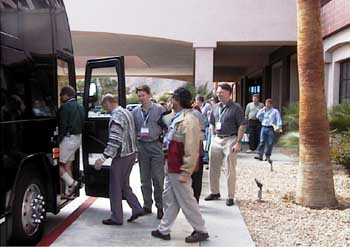
The afternoon session of Hossain Kazemi's "Simple Tools for NPDES Compliance on Construction Sites" included a field trip to a construction site in nearby Palm Desert where a multitude of erosion control devices and techniques were demonstrated by the suppliers themselves. Here the class attendees are shown boarding the bus for the field trip which several said was the most informative part of any session they had attended.
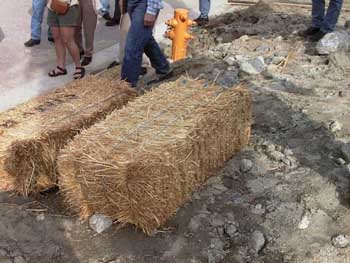
This straw bale illustrates an old standby in erosion control that instructor Hossain Kazemi says would work better if it were broken down and spread around as straw mulch. It was clear that the expert thought there were better alternatives to both straw bales and silt fences. "Other things just work better," he said. To illustrate this, he pointed out how people can see an entire car floating down a street during severe flooding and, yet, they expect straw bales to stay put.
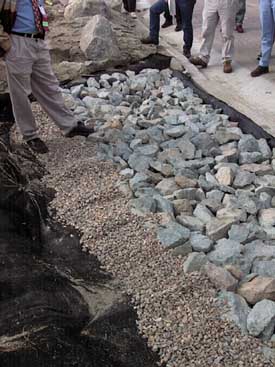
Here is an excellent example of a construction entrance designed to remove most of the dirt that may cling to vehicle wheels as they exit and enter the site. This is one of the BMPs designed to keep dirt off the street and out of the storm drains. All the rock is contained by a fabric liner, which makes it easier to remove the rocks once they become muddy with accumulated dirt. Large rocks, which have been found to remove tire dirt the most efficiently, extend to a depth of 1 foot here. The typical minimum depth recommended is 6 inches. "Two inches of drain rock is worthless," according to instructor Hossain Kazemi. Also notice the triangular buffer of fabric-covered foam rubber which forms a dike to keep rocks in. While this method works extremely well, it was also brought up that there are other materials that work well including a scrap steel barrier fence that has been laid down to form a washboard effect.
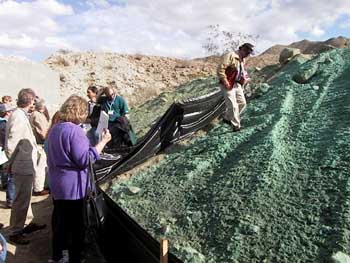
Here the class is shown several types of hydroseeding and binders designed to retard erosion while the slopes are vegetating. These materials include an acrylic co-polymer, applied 100 gallons per acre, which is popular in California since it is made of a latex byproduct that is recycled. It generally runs around 4 cents per square foot (not including seed), dries within 24 hours and lasts up to six to eight months. Also shown was wood fiber, which is applied with or without seed and costs around 2 cents a square foot. When applying the recommendation was to spray in all directions and follow manufacturer's direction very carefully.
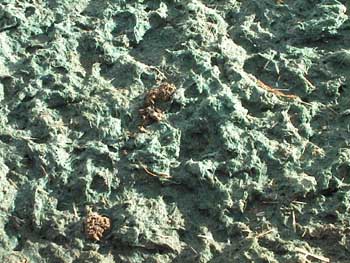
Pictured here is a close-up of a bonded fiber matrix which, although expensive—$3500 per acre, sets up quickly and can be applied under emergency conditions without waiting for dry weather. It is similar to blankets with the advantage of being applied by spraying and can be safely applied on steep hillsides.
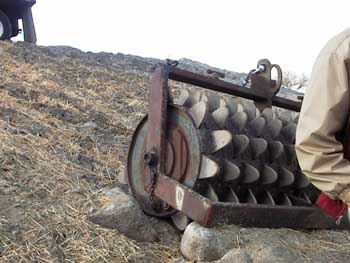
The old standby-straw-may be applied and "incorporated" by rolling this punching device up and down the slope (it is attached to a truck with a wench at the top). Straw is the least expensive erosion control material, costing around $100 per acre depending upon the type; wheat is least expensive but may germinate; and rice, while more expensive, has less germination.
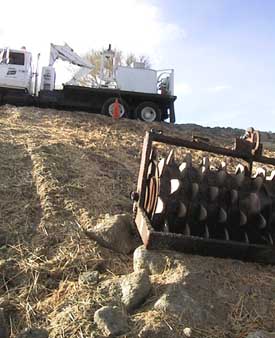
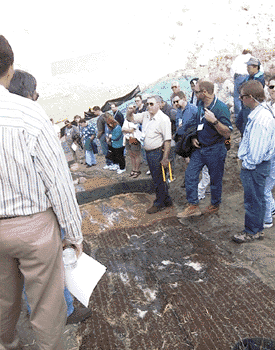
Barriers such as this EnviroBerm are effective in slowing the velocity of water, which is channeling down a slope. Proper installation is important with careful attention paid to positioning each end. It can also be easily moved and used five or six times. It helps prevent water ponding, which can prevent vegetation. Also, notice the fabric lining the channel, which also serves as a retardant and as a filter for water cascading down a steep slope.
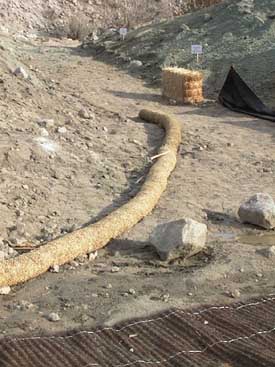
Fiber rolls, which are nothing more than straw captured in a roll by mesh, are amazingly effective as an easily handled barrier, which can be placed along hillsides, in gutters to slow the flow of water along curbs, or around storm drains.
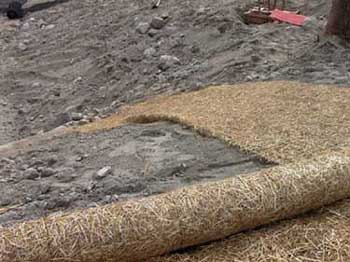
A tip to further help slow water down a slope was to leave the final roll of a roll of straw in tact to serve in much the same manner as a fiber roll. This can be done at the toe of the slope or in the middle as shown here. Such rolls are often buried slightly in a trench and secured with stakes.
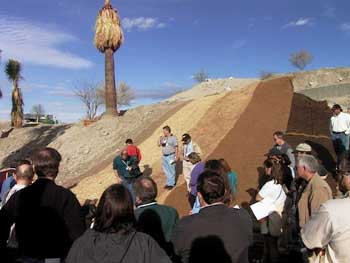
A display of a variety of erosion blankets was featured with manufacturers explaining the advantages and disadvantages of each.
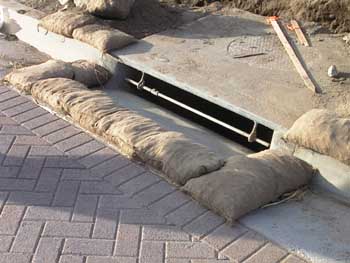
Bags filled with rocks are preferable to sand bags to protect stormdrains from polluted stormwater. Notice the pavers used on the streets. These pavers, while expensive, enable the developer to maintain all the water on the property. Water draining through the pavers is drained to the golf course for irrigation or into dry wells for storage. It was also pointed out that pavers, in addition to being more pervious than asphalt or concrete, also are easily moved when pavement cuts are necessary to repair utilities.
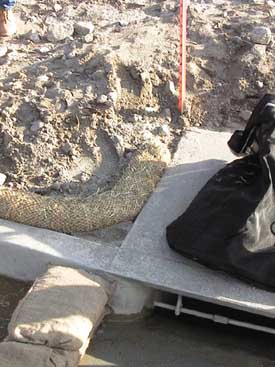
Here fiber rolls are placed along the curb to effectively prevent soil from running into the streets and onto the storm drain. Notice bags also protecting the storm drain.
